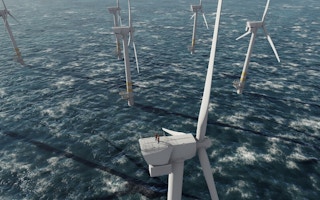To heed the warnings of climate scientists and achieve net-zero greenhouse gas emissions by 2050, governments and businesses will need to spend US$3.5 trillion more annually than they are spending now on infrastructure such as clean energy farms, a more efficient electric grid, and low-carbon transport by mid-century, according to a report by McKinsey.
To continue reading, subscribe to Eco‑Business.
There's something for everyone. We offer a range of subscription plans.
- Access our stories and receive our Insights Weekly newsletter with the free EB Member plan.
- Unlock unlimited access to our content and archive with EB Circle.
- Publish your content with EB Premium.
Some $2.5 trillion annually — half the gross domestic product (GDP) of Japan — will need to be spent in Asia between 2021 to 2050, which amounts to 27 per cent of the global average spend needed each year, said the report.
Meeting the mid-century carbon neutral goal is essential if the planet is to avoid the worst consequences of a warming world, such as calamitous extreme weather. Extreme weather events resulted in record economic damages last year.
The report stated that spend on physical assets to achieve carbon neutrality would total $275 trillion globally through to 2050 — approximately $9.2 trillion per year, equivalent to three times the GDP of India — as high carbon-emitting economic activity is phased down and low-emissions activities ramped up.
Currently, about two-thirds of energy and land spending is on high-emissions products and infrastructure. That proportion will need to be reversed — with 70 per cent of spend going on low-carbon infrastructure over the next 29 years.
The transition cost could be much higher if the shift to a low-carbon society is “disorderly” and disrupted by shocks such as energy shortages and price increases. It will also be unevenly distributed between geographies, with far greater spend needed in fossil fuel-dependent developing countries, the report cautioned.
McKinsey’s calculation on Asia’s climate-related spending echoes the findings of a report from consultancy Wood MacKenzie, published earlier this week, which finds that major Asian economies including China, India and Indonesia will feel economic pain from the energy transition, with China’s economy to shrink by $20 trillion — three-quarters of its GDP in 2020.
Asia’s key economies, including Japan (2050), China (2060), Indonesia (2060) and India (2070) have set net-zero emissions targets, although observers have cast doubt over the credibility of these targets, because of a lack of detail in how they will be met.
The region’s emerging economies have been promised aid to meet climate goals by industrialised nations as part of the Paris climate accord, although the amounts received are well short of the pledged $100 billion a year, an issue that was not resolved at the COP26 climate talks in November.
The industries most exposed by the net-zero transition are those more reliant on fossil fuels, which currently form about 20 per cent of global GDP. Another 10 per cent of GDP is in sectors whose supply chains have high emissions, such as construction, the report noted.
Low-income households everywhere may be affected, the report found, for example due to upfront capital costs they may need to incur, to buy low-emissions products like electric vehicles and more efficient air-conditioning.
McKinsey’s report projected that about 200 million jobs would be created from a pivot to a net-zero world by 2050, while 185 million jobs would be lost, as legacy fossil fuel-dependent careers become redundant.
Economic growth areas would come from new markets for low-emissions goods and finding efficiencies from decarbonisation.
The report estimated that the bulk of the $275 trillion net-zero spend will need to be made sooner rather than later. Spending would need to rise to 8.8 per cent of GDP between 2026 and 2030, up from 6.8 per cent today, but could taper off over subsequent years towards 2050.
“The economic transition to achieve net-zero will be complex and challenging, but our findings serve as a clear call for more thoughtful, urgent, and decisive action, to secure a more orderly transition to net-zero by 2050,” said Dickon Pinner, senior partner at McKinsey.
“The question now is whether the world can act boldly and broaden the response and investment needed in the upcoming decade.”

















